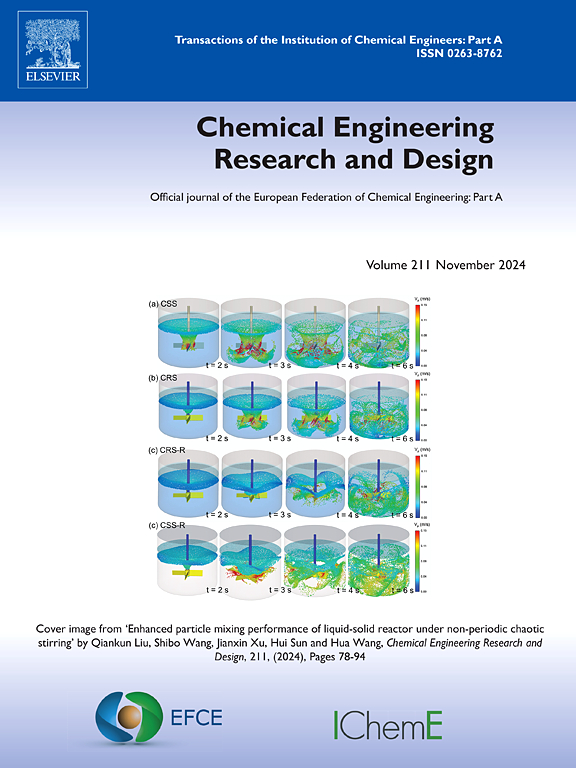Experimental and ANN modeling of kerosene fuel desulfurization using a manganese oxide-tin oxide catalyst
IF 3.7
3区 工程技术
Q2 ENGINEERING, CHEMICAL
引用次数: 0
Abstract
This research pioneered the use of a nanocatalyst composed of manganese oxide (MnO2) and stannic oxide (SnO2) to effectively remove dibenzothiophene (DBT) from kerosene fuel through the catalytic oxidative desulfurization (ODS) process, using hydrogen peroxide (H2O2) as the oxidant. Impregnating SnO2 with varying amounts of MnO2 was used to manufacture the catalyst. The oxidation experiment ran in a batch reactor with varying reaction times and temperatures to determine optimal conditions. High MnO2 dispersion over SnO2 was shown by catalyst characterization data. Under optimal operating parameters (catalyst type: 5 % MnO2/SnO2, reaction temperature: 75 °C, and reaction duration: 100 min), the results demonstrated a maximum DBT removal efficiency of 82.84 % from kerosene fuel. This research also provides the construction of Artificial Neural Network (ANN) model to simulate the upgrading of kerosene fuel via desulfurization process. There has been a growing trend toward the diversified use of ANN to represent steady state systems in chemical engineering. MATLAB's code was employed for matching the experimental data to the artificial neural network (ANN) model. The resulted data showed significant agreement between the experimental and predicted outcomes, with regression coefficients (R2) of 0.99902, 0.99986, and 0.99961 and mean square errors (MSE) of 0.266, 0.272, and 0.104 for 0 % MnO2/SnO2, 1 % MnO2/SnO2, and 5 % MnO2/SnO2 respectively. This interactive model provided a solid foundation for understanding the novel behavior of the oxidation process.
使用氧化锰-氧化锡催化剂进行煤油燃料脱硫的实验和 ANN 模拟
这项研究率先使用由氧化锰(MnO2)和氧化锡(SnO2)组成的纳米催化剂,以过氧化氢(H2O2)为氧化剂,通过催化氧化脱硫(ODS)工艺有效去除煤油燃料中的二苯并噻吩(DBT)。制造催化剂的方法是在二氧化锡中浸渍不同量的二氧化锰。氧化实验在间歇式反应器中进行,反应时间和温度各不相同,以确定最佳条件。催化剂表征数据显示,二氧化锰在二氧化锡上的分散度很高。在最佳操作参数下(催化剂类型:5 % MnO2/SnO2,反应温度:75 °C,反应时间:100 分钟)下,结果表明,二氧化锰在二氧化锡上的分散度很高:结果表明,煤油燃料中 DBT 的最大去除率为 82.84%。这项研究还构建了人工神经网络(ANN)模型,用于模拟煤油燃料的脱硫升级过程。在化学工程中,越来越多地使用人工神经网络来表示稳态系统。使用 MATLAB 代码将实验数据与人工神经网络(ANN)模型相匹配。结果表明,实验结果和预测结果之间存在明显的一致性,0 % MnO2/SnO2、1 % MnO2/SnO2 和 5 % MnO2/SnO2 的回归系数 (R2) 分别为 0.99902、0.99986 和 0.99961,均方误差 (MSE) 分别为 0.266、0.272 和 0.104。这一交互模型为理解氧化过程的新行为提供了坚实的基础。
本文章由计算机程序翻译,如有差异,请以英文原文为准。
求助全文
约1分钟内获得全文
求助全文
来源期刊

Chemical Engineering Research & Design
工程技术-工程:化工
CiteScore
6.10
自引率
7.70%
发文量
623
审稿时长
42 days
期刊介绍:
ChERD aims to be the principal international journal for publication of high quality, original papers in chemical engineering.
Papers showing how research results can be used in chemical engineering design, and accounts of experimental or theoretical research work bringing new perspectives to established principles, highlighting unsolved problems or indicating directions for future research, are particularly welcome. Contributions that deal with new developments in plant or processes and that can be given quantitative expression are encouraged. The journal is especially interested in papers that extend the boundaries of traditional chemical engineering.
 求助内容:
求助内容: 应助结果提醒方式:
应助结果提醒方式:


